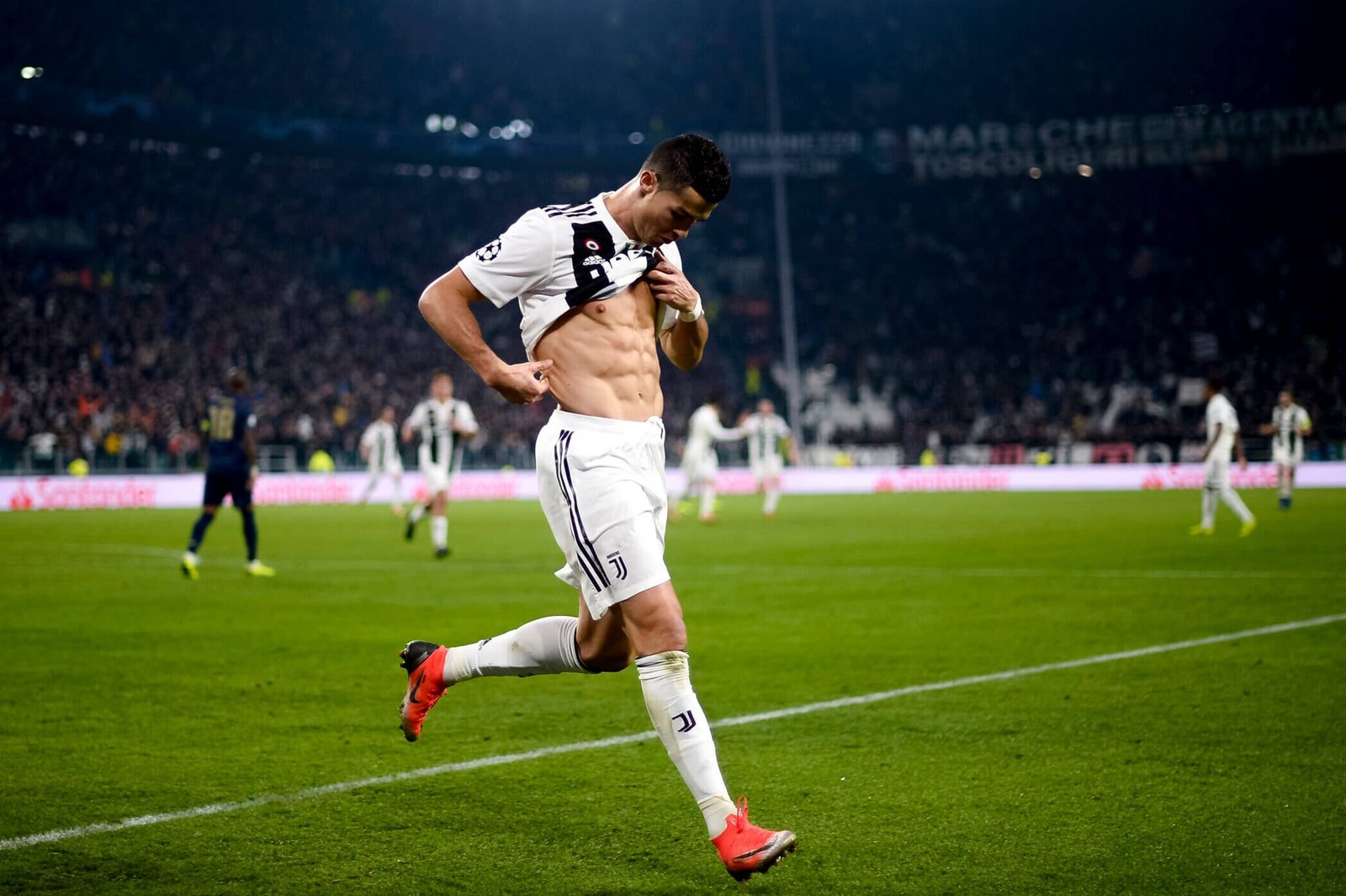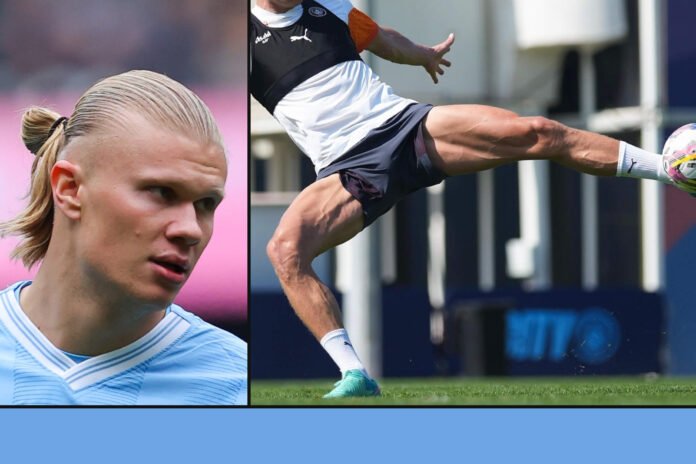What do you see when you look at the above picture of Erling Haaland, originally posted on his Instagram account last month?
For some, it’s an image that showcases just how extraordinary an athlete he is: the sheer size of the muscles in his legs. The definition that makes them look like they’re popping out from beneath his skin.
For others, it’s simply an illustration of how an elite athlete should look: lean and muscular. Nothing more, nothing less.
“It is what you should expect to see from a good athlete,” Anthony Turner, a professor of strength and conditioning at Middlesex University, tells The Athletic. “To varying degrees, if you put other professional footballers in that pose in that light, you probably could recreate that… Haaland is just maybe a bit more well-defined than others.”
“When you lift the leg up in that manner, every single muscle in that leg is firing,” says Phil Learney, a sports scientist and the founder of the Advanced Coaching Academy. “You see this with bodybuilders on stage — they lift their feet off the floor and all the muscles separate, then they slam their leg on the floor to keep that separation in place.”
Others, including Neil Parsley, a physical performance coach for Olympic athletes and footballers, are more impressed: “If there’s no real filter on that photograph then that is incredible… you can see virtually every muscle – you could do a physiology class on his legs. That muscle on his inner thigh, that’s his adductor muscles. You usually only see that on bodybuilders.”
Whatever your viewpoint, there is no denying that Haaland’s physique is impressive, especially when you consider where he started from.
“When he was young, he was fast but he wasn’t so fast and he was quite small,” said Tord Johnsen Salte, one of Haaland’s team-mates at Bryne, when speaking to The Athletic in May 2022.
“So he had to learn to adapt to being less physical than the others, he was so good at getting through on goal every time, even though he wasn’t faster than the defenders. Now he is a monster and can do both.”
Described then as a “skinny kid”, it was only once Haaland moved from his first club Bryne to Molde at the age of 16 that his physique started to change. He packed on 15 kilograms (2.3st) of muscle during his two years there, before being snapped up by Austrian Bundesliga champions Red Bull Salzburg in 2019.
Haaland as a ‘skinny kid’ at Molde in 2018 (Andrew Halseid-Budd/Getty Images)
Now 23 years old and staking a claim to become the greatest goalscorer the Premier League has seen, Haaland’s physical appearance is almost unrecognisable from what it was. One reason for that, which most agree on, is his genetic makeup, with a father who played more than 200 games as a professional footballer and a mother who was once the Norwegian heptathlon champion.
“Both sports require fast-twitch muscle fibres,” says Learney. “There’s an aerobic element, too, but there’s a lot of power in there.”
Haaland’s naturally lean physique also plays a role, says Learney — whenever the striker tenses a muscle, “you’re going to be able to see with this huge amount of definition”.
Body composition (the amount of fat and muscle that an individual carries) is something that is taken very seriously by Manchester City manager Pep Guardiola and his performance staff, with each player having certain standards that they have to meet.
Haaland is probably well below any body fat percentage ceiling that has been set for him and that is more than just genetics.
“His body composition is elite,” says Parsley. “His lifestyle, his nutrition, are all of a very, very high level. You don’t get that lean unless you are eating and sleeping right. That’s a big part of that photograph.
“Not many people have the discipline to get their body fat that low, it requires phenomenal discipline to live that lean. All these Instagram fitness people always have a photograph of them absolutely shredded. In reality, they do that for a photo shoot for one day and the rest of the time, they live probably a stone heavier.
“Haaland probably puts a little bit on during the off-season, but he’s living 11 months of the year like that.”
Haaland’s nutritional intake is crucial to maintaining the muscle mass he has built and the City striker has access to a personal chef to help ensure he gets what he needs — reported to be around 4,000 calories per day, including high protein, nutrient-rich foods, including offal.
Providing a male athlete has his energy balance correct (i.e. he is fuelling himself correctly) Parsley says that having such low levels of body fat allows him to maximise his performance from a movement perspective — speed, change of direction and overall output in a game. (It should be noted that this differs for female athletes, for whom such low levels of body fat can be detrimental not only to their performance but to their overall health.)
“Statistics now show that the total volume of running over 90 minutes across under-16 footballers and Premier League players is very similar,” says Parsley. “But it’s the high-intensity actions that differentiate under-16s on a scholarship from players at Manchester City and Liverpool. High-intensity actions are where the top teams and the top players live.
“That’s what you get from being like Haaland; that sharpness that he’ll get from being super lean is a differentiator.”
What about the muscle though? That is important, too.
“How big your muscles are is an indication of how much force you can produce,” says Turner. “The bigger your muscle, the more force you can produce. The more force you can produce, the faster you can run, the higher you can jump, the harder you can kick, the quicker you can change direction.”

Haaland won the treble in his first season with Manchester City (Anthony Devlin/Manchester City FC via Getty Images)
Muscle (and the method for developing it) is also beneficial when it comes to injury prevention, says Turner, because when you are training the big muscles (such as quadriceps or hamstrings), you are also training the connective tissue and putting load through the bones.
“So your cartilage is getting stronger, thicker and more dense, your ligaments and tendons as well, as well as your bone mass. You become more robust. You’re less likely to get injured.
“Footballers still have a high injury rate, but they are pushing themselves to the extreme, so that is to be expected. The stronger you are, the more robust you are because it’s all-round growth. It’s not just the muscle, it’s the connective tissue that keeps us together as well.”
One muscle that stands out prominently on Haaland’s legs is the vastus medialis oblique, otherwise known as the VMO, or “teardrop muscle” because of its shape. Positioned just next to the knee, it helps to control how the kneecap moves and provides stability, aiding in injury prevention.
It’s also important for multi-directional movements, says Learney.
“If you look at speed skaters, their VMO development is obscene,” he says “because it’s all lateral movement.
“Football’s lateral, they don’t run forward all the time. They don’t run backwards all the time. In rugby league, it’s all posterior development; players have very well-developed hamstrings, calves and glutes because they spend a lot of time running backwards.”
Hamstring development is also crucial in protecting the knee, says Learney, recalling an NFL player who once came to him for a strength assessment. “This American footballer was incredible in a straight line and diagonally but he could not move laterally and he couldn’t move backwards very effectively. So his knee was incredible in one plane of movement.”
Around six weeks later, the same player jumped to catch the ball during a game while travelling forward, landed and damaged his knee.
“When you jump and land like that,” continues Learney, “the thing that has to stabilise the knee is your hamstrings and his hamstring couldn’t do it, so his knee blew out.
“Haaland will be more than conscious about the fact he needs to bulletproof his body and the more muscle tissue he’s got surrounding his knee joints, the better.”
His large quadriceps are key to that, too, while they also help with acceleration, deceleration, and jump height.
How do you build legs like Haaland’s?
“There are three primary mechanisms of hypertrophy (muscle building),” explains Learney. “Mechanical tension, muscle damage and metabolic stress.
“Mechanical tension is somebody going into the gym and putting a lot of mechanical tension between the origin and insertion points of a muscle, which is resistance training. In Haaland’s case, he’s jumping, leaping and running on the pitch and then working on those modalities in the gym.
“He will also be working on range of movement, which means his tissue will develop in a very athletic way. Gymnasts are a great example of that.
“Then you’ve got muscular damage, which requires recovery to regenerate efficiently. Haaland spends a lot of time with recovery modalities like compression boots and pays a lot of attention to his sleep patterns. He uses things like seasonal affective disorder lamps and blue-light-blocking glasses.
“His metabolic stress will come from the fact he’s playing football at a very high level probably for hours and hours a day.”
While most commercial gyms contain fixed weights machines as well as free weights — barbells, dumbbells and kettlebells — most athletic facilities won’t contain any of the former. That’s because the primary objective of such machines is to help people isolate particular muscles when lifting weights as opposed to building muscle more functionally.
“Fixed machines were designed by bodybuilders,” says Learney. “Those machines mean I can take a huge amount of load and focus it all exactly where I want it.
“If I take a couple of free weights and do a chest press, I’ve got to stabilise the weights left to right, up and down, so my shoulder joint is working hard. But if I’m a bodybuilder doing a horizontal push movement on a machine, the main emphasis is to hit my chest. I’m not concerned about my shoulder stability. I’m concerned about putting all this pressure on my pectoral muscles.”

A physiology class in motion (Erling Haaland/Instagram)
Haaland’s focus in the gym is not image. It’s about becoming the best footballer in the world — the aesthetics come as a byproduct.
He focuses on functional movements — squats, single-leg exercises, such as lunges, reverse lunges and lateral lunges, sled accelerations (running with resistance behind him) and a lot of jumping, namely hurdle jumps and lateral jumps.
The big weighted movements, such as his squats, will be loaded up heavy with a low number of repetitions (reps), says Parsley.
“He’s training for strength and power, so he’ll do three to five heavy sets of between three and five reps,” he continues. “When you work in that rep range, you’re using your neuromuscular pathway, which is the connection between your brain and your muscles.
“All the muscle breakdown happens after about 25 to 30 seconds (of lifting), which is over six to eight reps. That’s when there’s enough time under tension for classic bodybuilding. A set of three to five reps takes you less than 20 seconds.”
Outside of the gym, there is the more specific side of training, such as sprints and one-on-ones. “So you’re training with intensity, practising against the central defenders and the wing-backs,” says Parsley. “That’s probably your most specific way of training, but that also helps with stimulating the leg muscles.
“There’s a continuum from the heavy strength work in the gym through to the weighted sled work, into acceleration, and specific one-on-one training.”
Gareth Bale (in his Real Madrid era) and Cristiano Ronaldo have been noted for having similarly impressive physiques, but many elite footballers do not have such visible musculature.

Cristiano Ronaldo has long been famed for his physique (Nicolo Campo/LightRocket via Getty Images)
Whether you need legs like that can depend on the position you play, says Turner. “If you’re a professional footballer, you’re not going to be far off having a good muscle mass, but it’s on a scale. At one end, you might have a long-distance runner who covers loads of distance but has very small legs. At the other end, you might have a powerlifter — someone who is super strong and fast.
“Footballers sit in the middle. They have to cover a lot of distance, but they also have to produce a lot of force. So they are going to need a good amount of muscle mass but they also need to cover a lot of distance. How much distance they need to cover will ultimately determine how big they get.
“Let’s say you put every pro footballer on a bodybuilding program over the off-season and they all come back huge. As soon as they started training, their body would adapt to the demands of that environment and that environment now is to cover distance. So their bodies would all have to shrink to accommodate a muscle that can produce force and cover distance.
“Some people’s muscles would shrink more than others. Haaland would retain more than someone in the middle of the park who needs to cover a lot of distance.”
Basically, if you want someone to play the way Haaland plays, then yes, it helps to have legs like that.
Are there downsides to carrying such muscle? In a word, no (unless you count the jealousy of fellow pros, jokes Parsley).
“There are some people that assume big muscles mean that you’re slower, which is a myth,” says Turner. “They’re thinking about bodybuilders, whose only goal is to get big, but beyond bodybuilding, it just can’t happen. The more force you produce, the faster you move.”
Alongside the genetic factor, one of the biggest differentiators between a group of players who might all spend an hour a day in the gym and three out on the pitch is what they do with the other 20 hours of their day.
Haaland is renowned for doing very little, which allows his body ample time to adapt and recover from the training he puts it through.
“It takes energy to build your body, to continually refine it into whatever the environment needs,” says Turner. “People who don’t give themselves that time because of whatever stresses are going on in their life, whether that’s self-induced or not, their body is using energy to deal with that stressor, instead of using that energy to refine the body.”
The most important aspect of Haaland’s physique probably isn’t anything physical at all though. It’s his mind.
“He’s obviously got great genetics,” says Parsely, “but he’s also been brought up around sports people so mum and dad will be working on his mindset when he’s young.”
Parsley has had a first-hand insight into the work ethic of the Norwegian. A few years ago, he was working with England during an international break on a training camp in Spain when he spied a familiar figure running on a back pitch, alone.
It was Haaland. Without an international fixture to play in, the striker had taken himself off for some sun and extra training.
“That’s symptomatic of that elite mindset and performance level,” says Parsley. “Some players need to maximise their physicality because their skills aren’t as good. But if you get someone with an A-plus discipline and physicality and you put that with an A-plus tactical and technical ability, that’s when you get the gold medalist.”
(Top photos: Getty Images, Instagram)
Read the full article here


